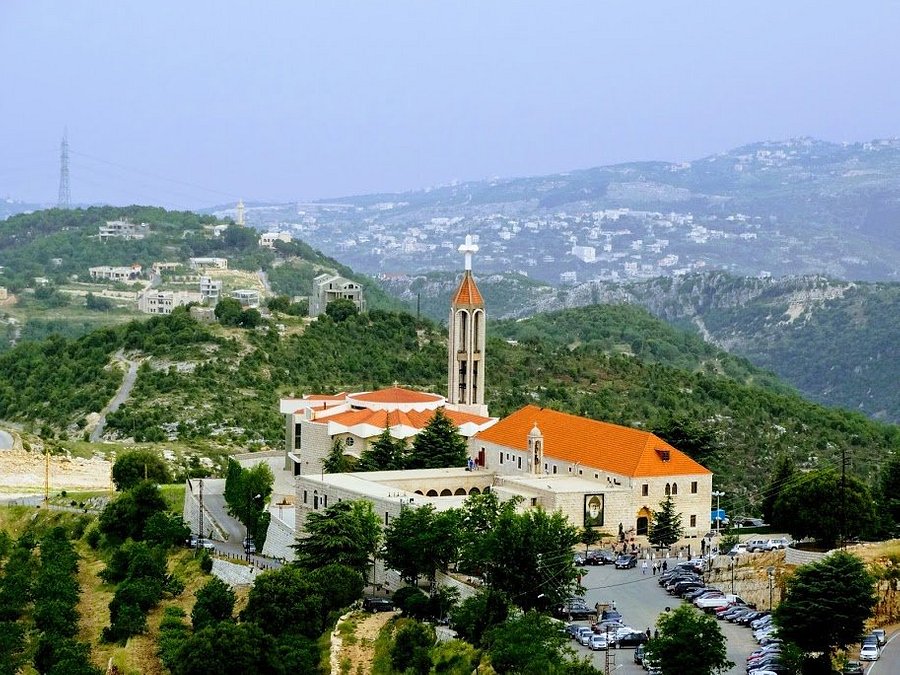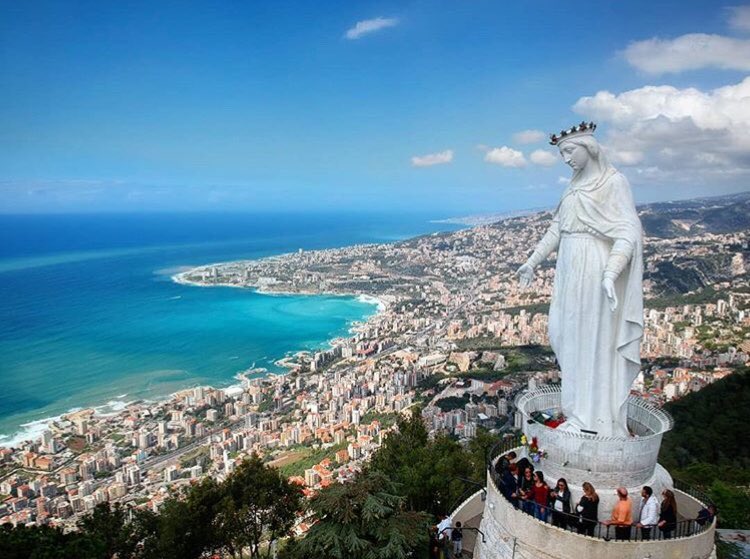![]()
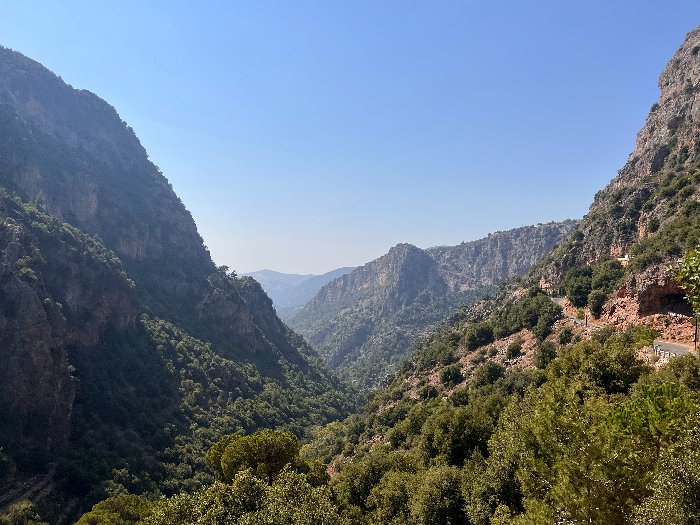
View down the rugged Qadisha Valley, the “Holy Valley” of Lebanon, near Bsharri, Lebanon
On the Road in Lebanon
Unitas: Friends of Lebanon Pilgrimage to Lebanon, September 2022
“After being here, what you are going to write is going to change completely — you won’t want to write about politics any more.” –Tony Assaf, member of the Board of Advisors for our “Friends of Lebanon” initiative, as we began our first pilgrimage to his beloved Lebanon. Our “Friends of Lebanon” initiative was launched on the day after the terrible explosion in the port of Beirut, Lebanon, of August 4, 2020
“Before the beginning there was love. Through it, everything was created from all eternity; without it, nothing would have existed. From the very beginning love existed, which is the foundation of the universe, the law, and the end of all things. Apart from love, nothing will remain, everything will perish… Man is fulfilled only through love; he attains the truth only in God. He belongs to God, because he is the son of love, the son of God, and his true dwelling is in God.” —opening words of a homily entitled “Christ is the Truth of Incarnate Love” by St. Charbel Makhlouf (1828-1898). St. Charbel is most beloved saint of Lebanon. He was a Maronite monk in the late 1800s in Lebanon, living in utmost simplicity and peacefulness, devoting his life to prayer and manual work. His tomb has become one of the holiest shrines in Lebanon, and thousands have testified to miraculous healings through his intercession. We visited his tomb in September. We report on our pilgrimage below
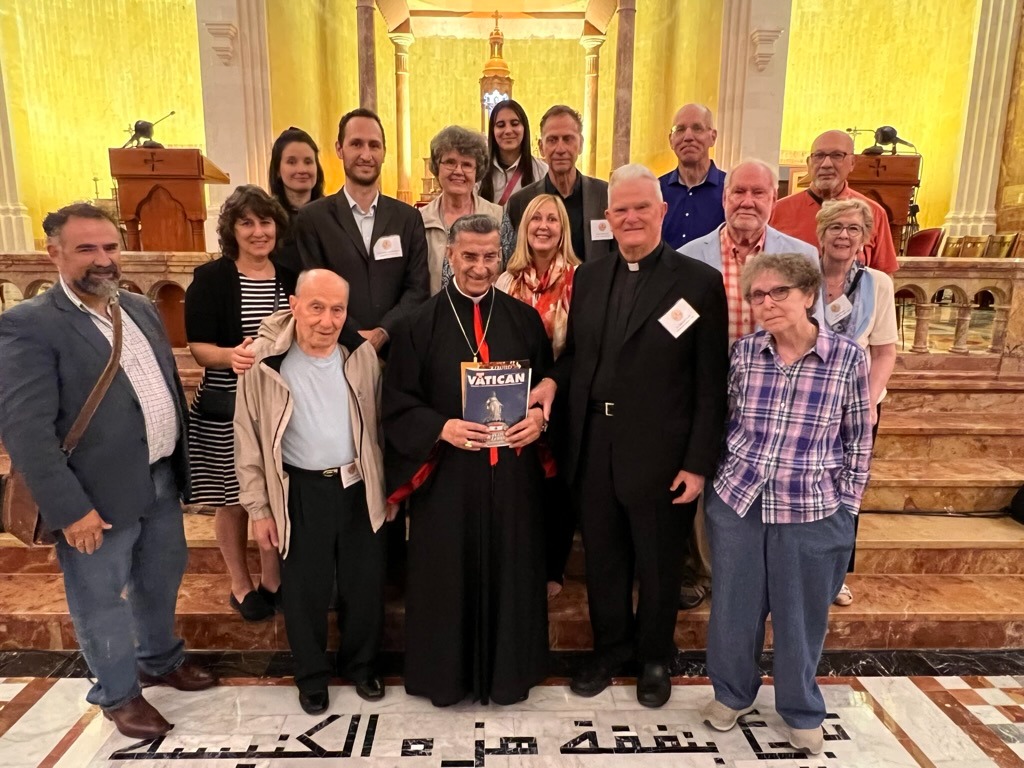
Our Unitas: Friends of Lebanon delegation met with Maronite Patriarch Bechara Boutros Raï at his summer residence in Dimane on September 18, 2022. The Patriarch encouraged us in our mission
Lebanon Report 2022, #10: Thursday, November 3
Lead Story
Unitas Fall Pilgrimage to Lebanon: “Extraordinary”
By Christopher Hart-Moynihan, Director, Friends of Lebanon Project (link)
During the second half of September, Urbi et Orbi Communications carried out our first pilgrimage to Lebanon. We brought a delegation of 10 “Friends of Lebanon” from the United States to Lebanon from September 17-25 as a part of our Unitas: Friends of Lebanon initiative.
The pilgrimage to Lebanon was conceived with several goals in mind.
First, we wanted to allow our pilgrims to meet with the people in Lebanon who have been supported by the work Friends of Lebanon has been doing for two years in this country, which has experienced profound tragedy these years.
Second, we wanted the pilgrims to understand better the social, political, and economic challenges Lebanon faces — the continued peaceful coexistence of Christians and Muslims in the country being one of the most significant of these.
But third, and most important of all, we wanted to offer the pilgrims an opportunity to go on a spiritual journey to ancient sites of Christian pilgrimage in the Qadisha valley, to places of biblical significance such as the Cedars of Lebanon, and to sites of popular devotion such as the tomb of St. Charbel.
The kindness of the Lebanese
The pilgrimage bore much spiritual fruit. Perhaps the thing that most stood out for all who were present was the kindness of the Lebanese people.
It is difficult to put into words the openness, hospitality, and generosity that we experienced during our time in Lebanon. As we were welcomed into people’s homes and into their lives, we began to understand the “Lebanese spirit” — a spirit present in the towns and villages where Christians, Muslims and Druze have lived side by side for centuries, in the cave monasteries where Maronite monks fled to escape Ottoman oppression, and in the city of Beirut, where bullet holes from the country’s civil war (1975-1990) dot the facades of historic buildings and fashionable hotels, and cafes use back-up generators to keep the lights on during daily blackouts.
After a first afternoon and evening in Beirut, and an early morning Maronite-rite Mass, we drove up to the Qadisha valley in northern Lebanon, where we stayed for three nights. “Qadisha” is a word meaning “holy” in Aramaic, which was the lingua franca of the Near East for many centuries, and the language of Jesus.
“Please continue”
On our first night, we were able to attend a Rosary service at the summer residence of the Maronite Catholic Patriarch, Cardinal Boutros Bechara Raï, in Dimane. At the end of the service, the pilgrims met Patriarch Raï and we gave him a short update on our work to support Christians in Lebanon over the past two years. He told us, “Thank you very much and please continue. This work is very important.”
The following day, we drove down into the valley, a massive and imposing geological wonder that has served as a place of refuge for generations of Maronite Catholic faithful. At the St. Elisha monastery, we saw a small room, carved out of the rock, where several Maronite Patriarchs had lived during the 16th and 17th centuries, when the Church in Lebanon was being persecuted by the Ottoman Empire. The next day, our last full day in northern Lebanon, we visited the Kahlil Gibran museum in the town of Bsharri and then the Cedars of God, which grow high on the slopes of the mountains above the valley.
The awe-inspiring landscapes of the Qadisha valley and the surrounding area gave us a new understanding of and appreciation for the Maronite Church, which was based in and around the valley for so many centuries, and whose saints and hermits have truly made this a “holy” valley.
Our Lady of the Light
The second phase of our pilgrimage was centered on Beirut and holy sites in the surrounding area. Leaving the Qadisha valley, we stopped at the Orthodox monastery of Our Lady of Nourieh (Our Lady of the Light), a popular Orthodox pilgrimage site overlooking the Mediterranean Sea, which was followed by lunch and an exploration of the ancient city of Byblos.
The following day, Thursday, was focused on visits to recipients of the “short-term help” that Unitas: Friends of Lebanon had provided following the August 4, 2020 Beirut port explosion. This help was in the form of food boxes, basic necessities and water purifiers, which recipients told us had made a huge difference in their daily lives.
Hearing the testimonies of people who continue to struggle, month after month, to provide basic necessities for their families and send their children to school was eye-opening and greatly moving for all who were present. Seeing the great need that ordinary people are still finding themselves in reinforced our commitment to continue the work of supporting Lebanon.
The Guardians of the Holy Fire
Another concrete way for us to support Lebanon, and the Christian community there, presented itself that evening, at a dinner held with the Guardians of the Holy Fire, a gathering of lay Orthodox leaders in Lebanon. At this meeting, the Guardians proposed a collaboration — an event in September 2023, to raise awareness about the traditions of the ancient Christian Churches in Lebanon and the rest of the Middle East. We agreed to hold such an event as a Unitas gathering, where Catholics and Orthodox will come together and discuss critical issues.
Also speaking at this event next September will be Habib Malik, an Associate Professor at American Lebanese University, with whom our group had dinner the subsequent evening. The son of the illustrious Charles Malik (who served after World War II as President of the General Assembly of the United Nations and participated in the drafting of the Universal Declaration of Human Rights in 1948), Malik gave us his thoughts on the future of Lebanon and told us he would be happy to mark the 75th anniversary (in 2023) of the drafting of the Universal Declaration with us at next year’s Unitas event. We hope you can make plans to join us next year in September in Lebanon for this gathering.
On the final day of our pilgrimage, Fr. Jim O’Neal, one of our pilgrims, celebrated Mass at the tomb of St. Charbel, perhaps the holiest site in Lebanon, after an illuminating and unexpected encounter with Fr. Louis Matar, the priest who has tracked the thousands of Charbel’s miracles over the years.
What stayed with us, and with our pilgrims, were these unexpected things:
—an offer of sharing a meal in the officer’s club of the Lebanese Army next to the Cedars of Lebanon;
—being invited to share tea in a family’s home in Byblos, and meet their children (they gave us a gift of honeycomb from their farm in their home village, and homemade Lebanese cake for dessert);
—meeting a father and son, both doctors, who have been running a hospital in northern Lebanon for the past 20 years, and learning about the challenges that the healthcare sector is facing in Lebanon during the current crisis.
Multiple pilgrims highlighted these “encounters” as the most remarkable part of the time in Lebanon, and all 10 pilgrims have now become advisors to the Friends of Lebanon project.
One pilgrim wrote: “The people and their country have left deep impressions in my heart and mind. Troubling sights of areas severely impacted by the explosion two years ago lie in contrast to the magnificent beauty of the hills and the blue sea surrounding much of Lebanon. The history of people of faith was almost palpable in monasteries we visited. As the days move further along, I recall moments, visits and human exchanges that hold great meaning. Faces and places come to mind and I am moved to prayer. The Pilgrimage may have actively ended, but the journey in prayer and faith with unforgettable people still lives.”
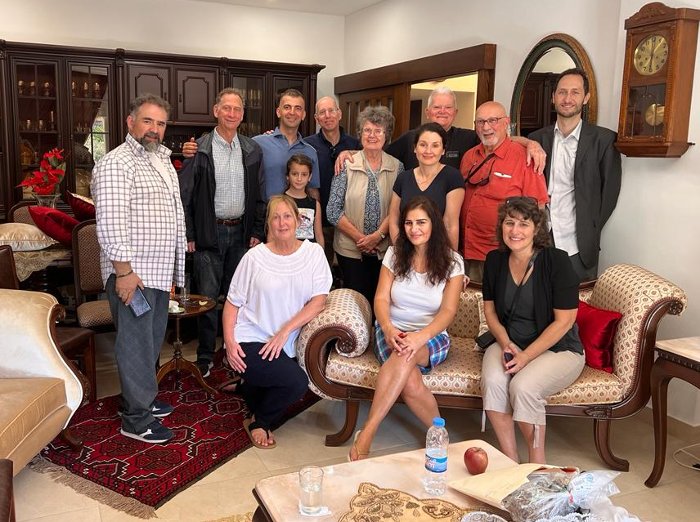
Sharing tea in a Lebanese friend’s home near Annaya, in Lebanon, on the way to the shrine of St. Charbel
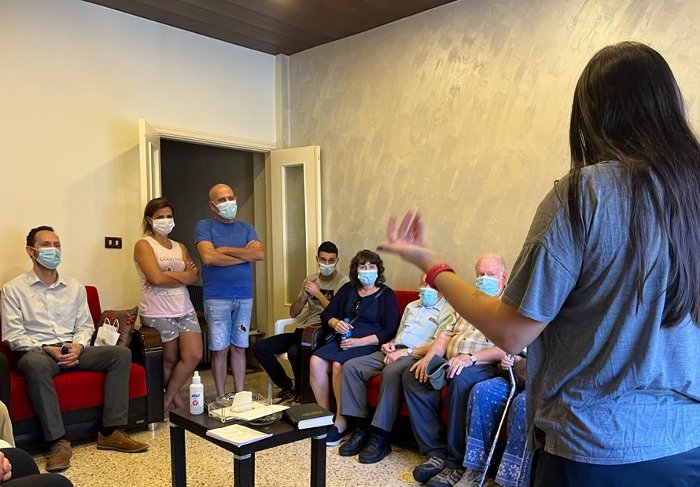
Meeting with aid recipients in downtown Beirut on September 22, 2022
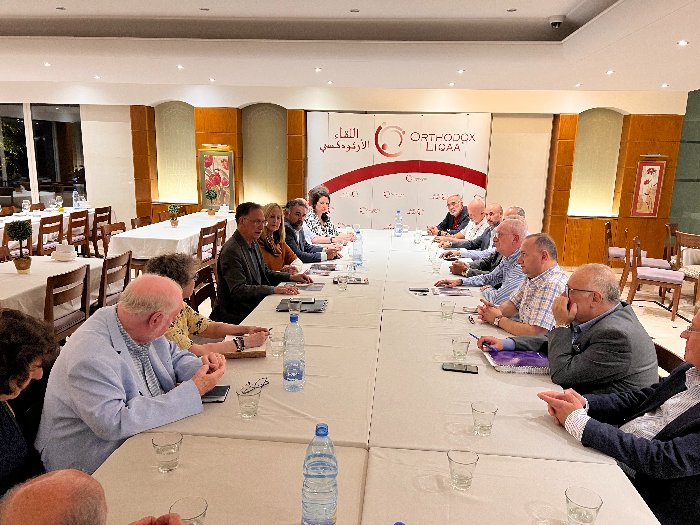
Meeting with the Guardians of the Holy Fire. The name of the group is Orthodox Liqaa, or “Orthodox Gathering”
Dossier
Unitas: Friends of Lebanon Delegation Meets with Orthodox Leaders, Aid Recipients, Dr. Habib Malik
On Thursday, September 22, our Unitas: Friends of Lebanon delegation met in Beirut with several individuals who had received aid from our organization. During the meeting, they told us (through interpreter Aya Naimeh) about their struggles since the August 4, 2020 explosion in the port of Beirut.
One family living in the Armenian sector of downtown Beirut (where many signs are written in the Armenian script alongside English and Arabic and many families have Armenian heritage), near the blast site, told us that electricity has not been restored since the explosion and that people are now dependent on unreliable private generators installed within each individual building for their electricity needs.
The explosion also affected the plumbing systems of thousands of Beirut residents. According to the families we talked to, because of electrical shortages, water is now being pumped for only a few hours each day. This means that water is likely spending extra hours sitting in underground pipes before reaching the tap, which can cause contamination as groundwater slowly leaches into the pipes and mixes with it. To assist residents who were concerned about having safe drinking water, Unitas: Friends of Lebanon donated 50 H2gO water purifiers to blast-affected families in Beirut in late 2021. The families that we met with told us that these had made a huge difference in their day-to-day lives, as they no longer had to pay for expensive bottled water.
More than two years after the blast, many apartments in downtown Beirut have still not been fully refurbished. One of the bedrooms in an apartment that our group visited was completely empty; all of the furniture had been removed after the door to the balcony shattered and the glass was propelled inwards by the force of the blast. The family’s two children had spent many months sleeping on the floor and the father was still spending his nights on a sofa. Funds donated by some of our “Friends of Lebanon” before the pilgrimage began were used to buy a bed for this man.
Orthodox “Guardians of the Holy Fire”
On the evening of the same day, September 22, our meeting with the Guardians of the Holy Fire — a group of Orthodox lay leaders who bring the holy fire from the Holy Sepulcher in Jerusalem to Lebanon each Easter Sunday, and who also carry out other initiatives to support the Orthodox Christian population in Lebanon — brought us a bit of inspiration for the upcoming year.
Orthodox tradition holds that the Holy Fire appears annually on the day preceding Orthodox Pascha (Orthodox Easter). At this time, blue light is said to emit within Jesus’ tomb, rising from a marble slab covering the stone bed believed to be that upon which Jesus’ body was placed for burial. The light is believed to form a column of fire, from which candles are lit. Pilgrims and clergy say that the Holy Fire does not burn them.
The Guardians of the Holy Fire is a group made up of about 20 leaders from different Orthodox Churches present in Lebanon. Most of them belong to the Greek Orthodox Patriarchate of Antioch, with some also belonging to the Syrian Orthodox Patriarchate of Antioch and the Armenian Orthodox Church. Although the Orthodox Church is the home of roughly 30% of Lebanon’s Christians and more than 10% of Lebanon’s population as a whole, the Orthodox are struggling to maintain their foothold in Lebanon. Many Orthodox who we spoke with during our pilgrimage told us that the Maronite Catholic Church — notwithstanding its own political, financial, and spiritual challenges — is still far beyond the Orthodox Churches in Lebanon in terms of financial resources and international support.
This small Orthodox group nevertheless has supported many Orthodox families and communities, especially after the Beirut port explosion, and they continue to do so as Lebanon endures a protracted economic crisis.
Similarly to our Unitas: Friends of Lebanon project, unity is one of their guiding principles. “We created unity through helping the people,” Marwan Abou Fadel, the group’s Secretary, told us. The group also highlighted how, in Lebanon, about 25% of students in Catholic schools are from Orthodox backgrounds.
We arranged a meeting with the Guardians of the Holy Fire in order to deepen our understanding of Lebanon, and particularly the situation of the Orthodox Christian community in Lebanon. As they welcomed us with a traditional Lebanese dinner and a round of arak, Lebanon’s (very strong) national liquor, a chance for collaboration presented itself.
A “Day of Unity” in Lebanon in September 2023
As the Guardians told us about the 2,000-year-old history of the Orthodox churches in Lebanon, their continued presence in this holy land, and the challenges they are facing, an idea took shape: a “Day of Unity” to be held in September 2023, which will provide a forum to raise awareness of this history and these challenges and to discuss the future of the Christian faith in Lebanon and the Middle East. The Guardians of the Holy Fire agreed to work with us to organize this event. We hope that this “Day of Unity” can be a springboard to helping Christian communities in Lebanon continue to thrive in the years to come.
On the penultimate night of our pilgrimage, we had the privilege of dining with Dr. Habib Malik, whose observations on Lebanese history and politics I have quoted several times in this Report. Dr. Malik is an author, a professor of history, and a frequent commentator on Lebanese affairs. Our discussion covered a number of topics, but perhaps the most important outcome of our meeting was Dr. Malik’s willingness to participate in the “Day of Unity” in September 2023.
Dr. Malik noted that the year 2023 will mark the 75th anniversary of the United Nations’ ratification of the Universal Declaration of Human Rights, a document that his father, Dr. Charles Malik, had a large part in drafting. We therefore agreed that, in addition to addressing the topic of the future of Christian faith in Lebanon, the “Day of Unity” will also address the legacy of the Universal Declaration over the 75 years since its ratification.
Dr. Malik agreed with our group’s assessment that ensuring access to quality education and healthcare seem to be the biggest current priorities for Lebanon. He stressed that young, educated Lebanese should be incentivized to stay in Lebanon, and not continue the “hemorrhaging of emigration” that has occurred since the port explosion and the onset of the financial crisis. He denounced the “mafia militia cartel” that has allowed the crisis to drag on for years, saying that “they hit [us] in people’s pockets [referring to the currency collapse and moratorium on bank withdrawals], physically at the port [referring to the August 4, 2020 explosion], and through education and healthcare [referring to the slow collapse of these two sectors].”
A Vatican “Fund for Future Generations”?
Dr. Malik is not sanguine about the ability of multilateral international organizations to improve Lebanon’s prospects. “All that the U.N. sees in Lebanon is more refugees,” he said, adding that aid for Lebanon’s native Christian population would be extremely unlikely to come from such organizations. Consequently, he returned to his idea of “a fund for future Christian generations,” to be “held abroad with clean hands and a rigorous vetting mechanism” for individuals managing the fund.
Dr. Malik believes that the Vatican is a natural choice for the management of such a fund, but that it could also be held and managed jointly by several institutions.
Malik believes that the wholesale corruption of Lebanon’s government means that even future bailouts such as IMF loans will likely be squandered.
“It is impossible to do anything through the government,” he said. “What is necessary now is to go directly to the schools, hospitals, ordinary people.”
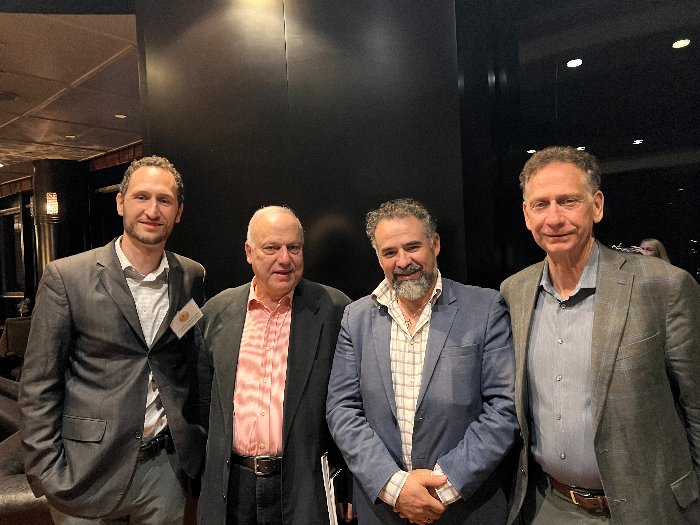
Meeting with Habib Malik in Beirut in September. From left, Christopher Hart-Moynihan (author of these Lebanon Reports), Habib Malik (son of Charles Malik), Tony Assaf, member of the advisory board of “Friends of Lebanon,” and Robert Moynihan, founder and editor of Inside the Vatican magazine
Above left, St. Paul’s Melkite Greek Catholic basilica at Harissa, Lebanon, in the hills above Jounieh, near Beirut. The Melkite Greek Catholics are the third largest Christian group in the country after the Maronite Church and the Greek Orthodox Church of Antioch. They are believed to constitute about 5% of the total population of Lebanon.
Above right, Our Lady of Lebanon in Harissa, overlooking the Mediterranean coastline of Lebanon near Beirut

An oil exploration platform in the Mediterranean Sea off the coast of Lebanon. The recent settlement of a border dispute between Lebanon and Israel (see article below) promises to bring new revenue into Lebanon’s government coffers in the years ahead, which may be sufficient to make Lebanon self-sufficient, and bring prosperity to the long-suffering country (Source: Flickr/US BSSE/Arab Center Washington, D.C.)
News
Lebanon and Israel on October 11 Reach Landmark Oil and Gas Agreement
One thing that surprised our Unitas: Friends of Lebanon delegation during our visit to Lebanon was the widespread optimism about Lebanon’s long-term economic future. “Everything here will be completely different in six years,” one Lebanese friend of ours predicted. “It will be like Dubai.”
The reason for this optimism, which was echoed by many Lebanese who we met, lies under the Mediterranean, miles off the coast of Beirut — untapped natural gas reserves that are said to rival those of Dubai and other petrostates. For years, the exploration of these reserves had been put on hold, as Lebanon had been unable to come to an agreement with its southern neighbor, Israel, on the maritime border between the two countries.
The agreement reached on October 11 changes all of that. Representatives of both the Lebanese and the Israeli governments settled the long-unresolved question of the offshore territory in dispute between the two countries. As a result, both Israel and Lebanon will be able to explore and develop oil and gas fields in their respective zones. As large European countries such as France and Germany will likely be looking for a more reliable source of natural gas as a result of the Russian war in Ukraine, both Lebanon and Israel stand to benefit immensely.
The agreement, which was officially signed on October 27, has received praise from all sides: Yair Lapid, the Prime Minister of Israel, called it a tremendous achievement, while Lebanese Deputy Speaker of Parliament Elias Bou Saab, who handled the negotiations along with U.S. Senior Advisor for Energy Security Amos Hochstein, hailed “the beginning of a new era between two countries that are technically at war.”
The deal will allow Lebanon to begin to explore the Qana field, an operation that will be carried out by the French company TotalEnergies. Meanwhile, Israel will be able to start extracting oil and gas from the Karish field.
***
Here below is the October 12, 2022 statement of the Lebanese Information Center, an organization based in Washington, D.C. which bills itself as “the largest grassroots organization of Americans of Lebanese descent, committed to building a free, sovereign, and democratic Lebanon for the good of the Lebanese people and in the interest of the United States of America,” on the agreement:
LIC Statement on the Lebanon-Israel Maritime Border Agreement
The Lebanese Information Center (LIC) welcomes the announcement of a maritime border resolution between Lebanon and Israel. This agreement is an important step toward a safe, secure, sovereign, and prosperous Lebanon. Considerable work remains and the LIC urges the Lebanese government to promote transparency in all economic matters in the maritime zone, remain committed to UN Resolution 1701, and seek diplomatic resolutions to its remaining border disputes.
The LIC is pleased to support the announcement of the Lebanon-Israel maritime border resolution. “We are particularly thankful to the efforts of the U.S. mediation team for their guidance and commitment to a diplomatic settlement, specifically, Senior Advisor on Energy Security Amos Hochstein, as well as for the political support and encouragement of President Joe Biden and Secretary of State Antony Blinken,” stated LIC President Dr. Joseph Gebeily. “A peaceful negotiation to such a sensitive topic was made possible through the deep ties and trust cultivated between the U.S. and Lebanon and the time, energy, and political willpower invested by the administration and Congress.”
The resolution of this long-standing maritime border dispute is a crucial step toward a more stable, secure, and prosperous Lebanon. This agreement will lower tensions between the two neighbors, promote security and stability in the south, and allow Lebanon to fully access its sovereign maritime resources, including oil and gas blocks. A peaceful settlement to a source of conflict demonstrates that a safe and peaceful Lebanon is possible not through violence committed by sectarian militias, but with negotiation and diplomacy by the legitimate representatives of the Lebanese people.
The LIC also stresses the importance of transparency in future negotiations by the Lebanese government. While the border resolution is a welcome development, the process has been overdue and opaque. As Lebanon prepares to explore the now-undisputed areas of its exclusive economic zone, the government must act with transparency and accountability. The economic benefit from any oil or gas extraction must be managed through a sovereign wealth fund for the benefit of the Lebanese people and not be diverted for graft, political favors, or to the sole benefit of corrupt officials.
The LIC also calls on the Lebanese government to continue the momentum of this diplomatic breakthrough. The government should work toward the full implementation of UN Resolution 1701, to include a full delineation of all its borders, including land and maritime borders with Israel as well as with Syria. The government should extend its authority over the whole Lebanese territory, control the borders and ports of entry, disarm all armed groups, and seek a long term solution to the Israeli conflict.
This historic border agreement is a positive step for Lebanon and demonstrates the possibility of diplomatic resolutions to difficult situations. The government should work in other spheres to settle disputes, open new economic opportunities for the people of Lebanon, and secure peace, stability, and sovereignty for the country and its citizens.
***
Some observers have pointed out that it will likely be many years before Lebanon can develop its offshore reserves, if indeed any are discovered, such as Imad Harb of the Arab Center Washington, D.C. Nevertheless, despite the challenges ahead, the agreement seems to herald a new era, and gives hope for a turnaround for Lebanon’s economy over the next several years.
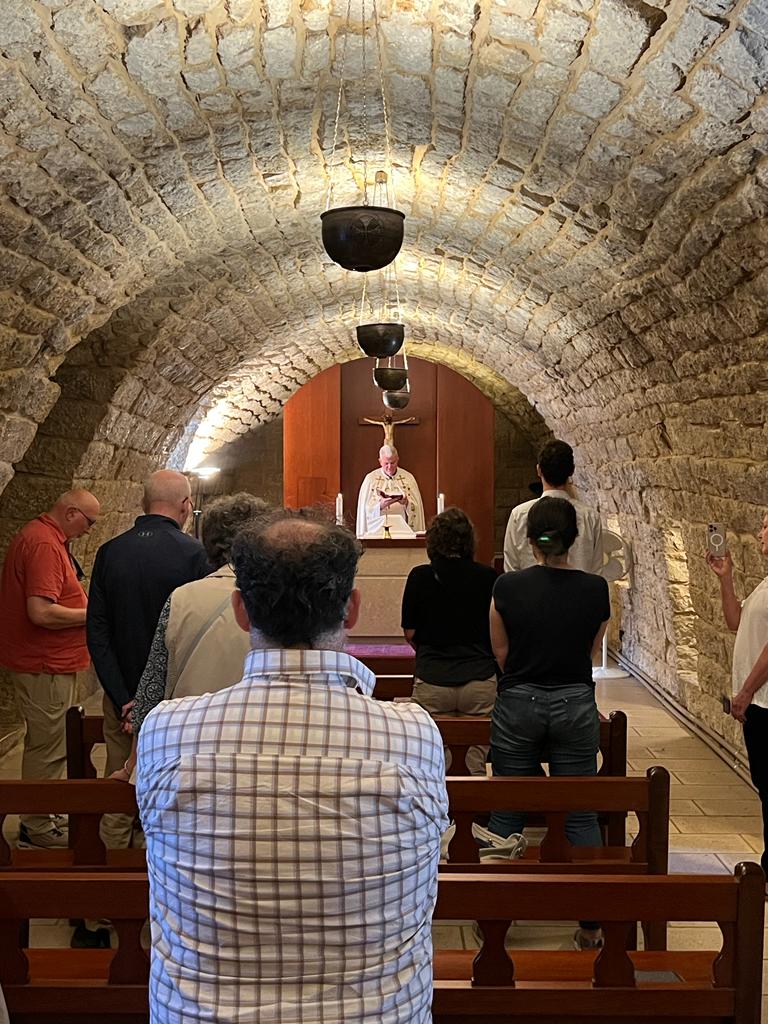
Fr. Jim O’Neal celebrates Mass for the pilgrims near the tomb of St. Charbel in Annaya, Lebanon in late September, 2022
Analysis: Beauty, Despair, and Hope in the Land of Cedars
There are many dates that have a special significance in Lebanon: the Christian holy days of Christmas and Easter, of course (both Catholic and Orthodox), as well as Muslim celebrations such as Eid al-Fitr (marking the end of Ramadan) and secular holidays like Lebanon’s Independence Day on November 22. Then there is the Feast of St. Charbel, usually celebrated on the third Sunday in July in Lebanon by Christians and Muslims alike (although the Catholic Church liturgical calendar has it occurring yearly on July 24 – my birthday). In addition to these, August 4 has now become a national day of mourning, in commemoration of the tragic Beirut port explosion on that date in 2020.
To all of these dates I now have to add one that has a personal significance: September 14, the day that I landed in Beirut.
While I had followed events in Lebanon closely since August of 2020, been writing this report since early 2021 and interviewed and worked with many Lebanese while working on the Unitas: Friends of Lebanon initiative, until September 14, I had not seen Lebanon with my own eyes.
That changed when our plane touched down in Beirut, making its way across the slightly-bumpier-than-normal runway to the terminal at Rafik Hariri Airport. At the immigration desk, lines were long, and once or twice the lights cut out, coming back only a few seconds later as the generators kicked in. On the other side, I was met by Aya Naimeh, who I immediately recognized after months of zoom calls discussing our work supporting youth in Beirut. We headed out into the Beirut evening. The air was warm and dry, freshened by the breeze from the Mediterranean.
As soon as you leave the airport, you realize that there is something a bit different at play in Lebanon. The green flags of Hezbollah and posters of the faces of militants fallen in the decade-old war in Syria line the road from the airport into the city of Beirut. I was later told that these flags and posters are made so prominent as a show of political power, indicating to all arriving visitors that the area around the airport is under the control of Hezbollah.
The other thing that struck me as we made our way through the city center was that Beirut was humming with activity, but that much of it was taking place in darkness. Taxis, buses, and mopeds all competed for space in the narrow streets, and many bars and restaurants appeared to be full, but the lights in many of the high-rise buildings, as well as many traffic lights, were dark. Before reaching the hotel, Aya took me by the building that housed Électricité du Liban, the government-controlled company responsible for 90% of electricity production and distribution in Lebanon. The building was dark and its windows were broken. “This building has been closed since August 4, 2020 [the day of the port explosion],” Aya told me.
Similar paradoxes were on full display throughout our time in Lebanon. Beirut and the northern coastal cities of Byblos (Jbeil in Arabic) and Jounieh are filled with the upscale restaurants and hotels built during the several decades of relative prosperity that followed the end of the civil war in 1990. Luxury cars still speed down the highways in a country where 75% of the population is living below the poverty line. Gorgeous multi-story modern homes dot the hillsides above the majestic Qadisha valley in the towns of Ehden, Hadchit, and Bsharri, but the streets are quiet and the numerous cafes empty and run down.
Perhaps even more unexpectedly to Western visitors like ourselves, used to narratives of inter-religious conflict, Lebanon’s many Christian pilgrimage sites — shrines to Mary, Jesus, and Christian saints like Charbel Makhlouf — are filled with Muslim visitors, with the women wearing their traditional head coverings. One Lebanese Christian told me that he believed many Lebanese Muslims were attracted to Christianity but reluctant to convert due to social pressure.
Then there is the weight of Lebanon’s long and tumultuous history — a history that many Lebanese cannot seem to quite wrap their minds around. At one dinner, seated next to a man who had served in the Lebanese Forces, a Christian militia and paramilitary group, during the Lebanese Civil War, I asked him what his experiences of the war had been. He shook his head, not wanting to enter into the topic. “All I learned was to avoid war, at all costs,” he said.
Witnessing the many extremes of Lebanon — wealth and poverty, beauty and decay, reverence and resentment — in the flesh can take you on a daily roller coaster from the highest of highs to the lowest of lows. But in the end, many of us found that in the heart of Lebanon there was peace: the peace of the turquoise waves lapping against the cliffs at the Orthodox monastery of Our Lady of the Light on a beautiful clear day, and the peace of the tiny church in the hills of Annaya where St. Charbel lived his last years seeking the divine — and where, stepping outside, your eyes can take in a sweeping vista from the mountains to the sea.
Perhaps this is the “message of peace” that St. John Paul II spoke of; if so, this message, and this hope, is very much alive in Lebanon.
And, while I still intend to write about politics and political leaders in this Lebanon Report, I hope to also find new ways to share this message and this hope with all readers. —CHM
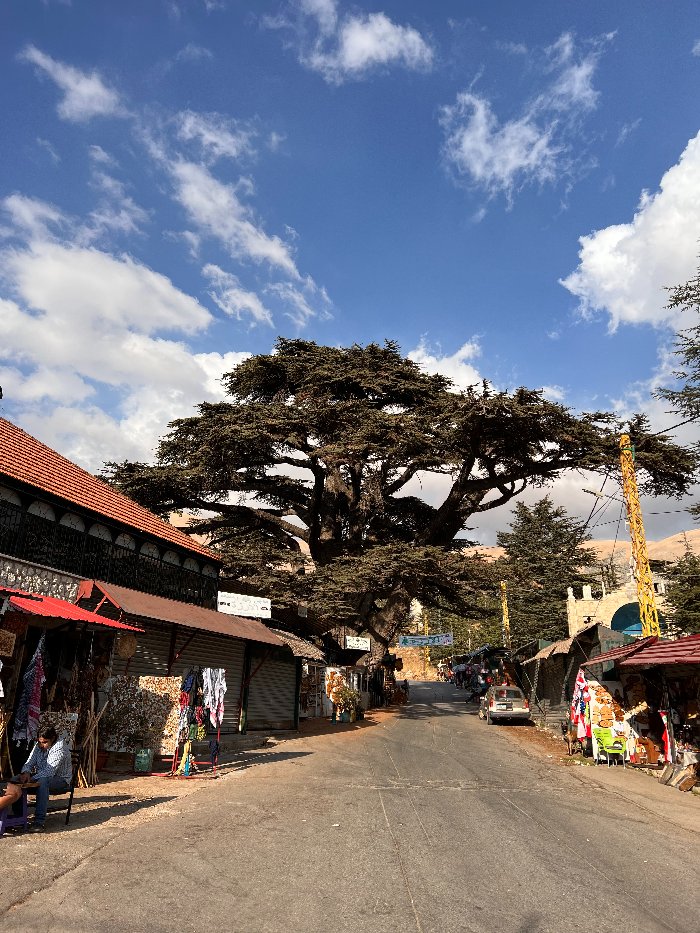
Among the famous Cedars of Lebanon. The cedar shown here is thought to be more than 2,000 years old…
Note: If you would like to support this type of writing about Lebanon from a perspective of support for the ancient Christian communities of that region, please consider donating here. Thank you.
Please consider becoming a “Friend of Lebanon,” and help us to bring “short-term help” and “long-term hope” to the land where Jesus Christ walked and performed miracles.
As a “Friend of Lebanon,” you will be able to participate in our Zoom calls with the people we are working with in Rome, Beirut, and throughout Lebanon to support Christians in their ancient homeland.
The Friends of Lebanon are gathering this Friday, November 4th, at 11:00 a.m. Eastern time, for a Meet and Greet with the leaders in Lebanon who are distributing the funds.
This Meet and Greet will be led by George Assaf, Aya Niameh, and Christopher Hart-Moynihan.
Join us tomorrow, Friday, November 4, 2022, by registering here.
We are so thankful to all of you for your support and look forward to seeing you all on Zoom tomorrow!
Please enjoy a complimentary digital edition of Inside the Vatican Magazine by clicking here.
Please consider joining us.
Christopher Hart-Moynihan
Director of Programs
Urbi et Orbi Communications

